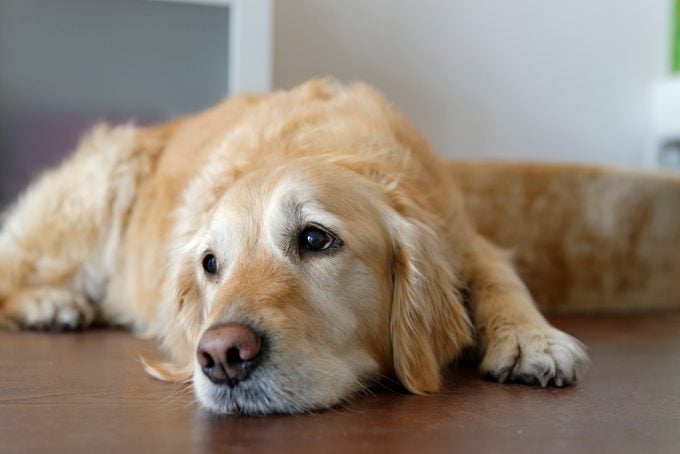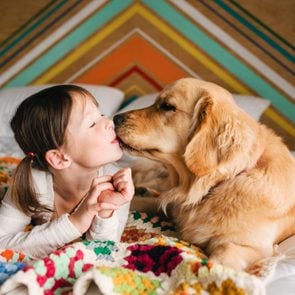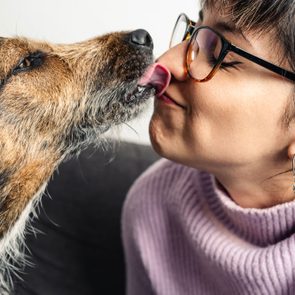How Long Is It OK to Leave Your Dog Home Alone?
Updated: Oct. 05, 2023

This expert advice will help you figure out the right amount of alone time for your pup—and keep him happy while you're away
They say a house isn’t a home without a dog. If your dog could talk, they would say a house isn’t a home without you. In a paw-fect world, we would spend every moment with our beloved doggos. But even if you train your dog to have excellent manners, pups are not always allowed in public spaces or welcome at social gatherings. So we give them a snuggle, say goodbye and leave them for anywhere from a few minutes to a few hours. But how long is it OK to leave your dog home alone?
Whether you have a puppy graduating from the crate or a dog with anxiety who gets stressed out when you leave, we have the info you need, straight from veterinarians and dog behavior experts.
Get Reader’s Digest’s Read Up newsletter for more pets, humor, cleaning, travel, tech and fun facts all week long.
How long can you leave a dog alone?
There’s no definitive answer to this question, because each dog has its own individual needs, but generally speaking, no longer than six to eight hours. After all, they’re not like cats, who have access to a litter box and can be left alone a lot longer. However, that’s just a base starting point. That number may be less or more depending on your dog’s age, health conditions, anxiety issues, quirks and preferences.
After you’ve taken those things into account, there’s still one vital factor to consider: your dog’s happiness. Dogs are highly social animals and thrive when they interact with humans. In fact, multiple studies have shown that the “love hormone,” oxytocin, increases when they are with us. In one experiment, scientists separated dogs from their owners and measured the dogs’ saliva for oxytocin. When the pairs were reunited, the levels were tested again—and the dogs’ oxytocin levels shot up by a whopping 60%! So even if you provide the ultimate doggy accommodations while you’re gone, leaving dogs alone for long periods of time can’t replace human interaction.
“What dogs really want from you is to feel safe, loved and cared for, even when you’re not around to share belly rubs and treats,” says Trevor Smith, a certified professional dog trainer at Pupford. With that in mind, here are some guidelines to help you figure out how long can you leave your dog alone.
A puppy
The most important things to remember about puppies? They have tiny bladders and high energy levels, which means they require more hands-on supervision. So how long can you leave a dog home alone if it’s a puppy? “If they are younger than 12 weeks old, leaving them alone for more than two to three hours is discouraged because they need frequent bathroom breaks, socialization and consistent training,” says Nicole Savageau, VMD, a veterinarian with The Vets.
An adult dog
Most dogs over a year old can handle being home alone for six to eight hours. “In general, dogs are pack animals and tend to like to be around their people or other dogs, so it is ideal to not leave them at home alone longer than you have to, especially if they are a single dog with no other pets at home,” says Dr. Savageau. Independent dog breeds like greyhounds, Bernese mountain dogs and Lhasa apsos, however, are OK with a little more me-time.
A senior dog
“Senior dogs might need shorter periods alone, around four to six hours, as they may have age-related health issues, such as dementia or urinary or fecal incontinence, or require more comfort and attention,” says Dr. Savageau. At what age do dogs reach senior status? Oddly enough, it has more to do with their size than the candles on their birthday cake.
According to the American Veterinary Medical Association, the longest-living dogs tend to be on the smaller side. Because of this, dogs are generally considered seniors when they reach the last 25% of the estimated life span for their breed. For example, a toy breed may live to be 16 years old, so they would become a senior around 12 years old. A giant dog breed, on the other hand, may have a life span of just six years, which means they’d reach senior status around four and a half years old.
An anxious dog
The answer to this one is very individual. “Because there are multiple types of anxiety, there isn’t a one-size-fits-all approach to how long your dog should be left alone,” says veterinarian Charles D. McMillan, DVM, owner of GoodVets in Atlanta. Whether your woofer has separation-related anxiety (“Don’t leave me alone!”) or confinement anxiety (“I don’t like being in a crate!”), you’ll need to observe their behavior to find a number that works for your dog.
Dr. McMillan recommends pet parents record their pets when they’re out of the home and note the signs of anxiety, such as barking, whining, howling, chewing, destructive behavior and peeing in the house, as well as when they begin and end. Your vet may suggest behavior-modification techniques, dog-calming products or medication to help. Smith also says a cozy corner can help your anxious pup. “Create a zen zone with their favorite things, like their blankie or the squeaky toy that’s a real hoot.”
A newly adopted dog
Whether you adopted an older dog or brought home a puppy from the shelter, your newly adopted furry friend will need time to adjust to their new home and the humans and pets living there. While there’s no cut-and-dry answer to how long you can leave your new dog home alone, Dr. McMillan says it is good practice to evaluate how your dog reacts to being left alone by starting in short increments before leaving for any prolonged periods of time.
It’s also a good idea to gather as much info as you can about your dog’s prior living conditions, circumstances and health, Dr. McMillan says. Aside from discovering any unknown health issues, this will clue you in on what your dog’s life has been like up until now—and how they might react to your absence. For example, if they were found as a stray, roaming the streets, or lived their entire life outside, being inside the house or in a crate alone for the first time could be very scary for them.
“Gradually build up their solo skills, starting with short and frequent alone-time adventures,” says Smith. Try leaving them alone for an hour to see how they do. A pet camera would come in handy for this, but you can also look for signs of stress, like torn bedding or chew marks on a crate.
What happens if you leave a dog alone for too long?
Accidents happen! That’s at the most basic level when your dog just can’t hold it, but in addition to the mess you’ll need to clean up, it could lead to doggy anxiety as well as an increased risk of developing a urinary tract infection.
Problem No. 2, says Dr. McMillan, is boredom, which often leads to destructive behavior. They may chew up household items like shoes, couches and even munch on the baseboards, and they can hurt themselves in the process. Boredom can also impact their quality of life and mental well-being. Dogs in this situation might become depressed and lethargic and no longer be interested in the things that once brought them joy, like playing fetch.
Tips for leaving your dog home alone

It’s never easy leaving your dog home alone, but you’ll feel a lot less guilty and set your mind at rest when you prioritize your pup’s happiness and well-being. Here are some tips to make your dog feel like a VIP (Very Important Pooch) while you’re away.
Stick to a routine
Dogs thrive on routine, so whenever possible, stick to a regular schedule of meals, playtime and potty breaks. “Make sure to take your dog for a good walk or play session before you dash off to work,” says Smith. “A tired dog is a happy dog!” When you do leave (and return), don’t make a big fuss. “Low-key exits and entrances help reduce separation anxiety,” Smith explains.
Set up a comfy climate
“Keep your home at a comfy temperature for your dog,” says Smith. While there’s no “sweet spot” temperature, some hairless and short-haired dogs may like it a little warmer than others. That said, there are indoor-temperature guidelines, courtesy of the Animal Welfare Act. Your thermostat shouldn’t drop below 50 degrees for short-haired dogs, puppies, senior dogs and sick dogs. On the flip side, 85 degrees is the max for all dogs to avoid heat stroke. Adjust the AC, provide fans or set up a comfy place in the basement to keep your pup from overheating.
Put out pee pads
Reusable puppy pads aren’t just for puppies with tiny bladders—they’re also handy for older and anxious dogs that may need to go more often. But you have to train your pet to use it. When you spot the signs your dog has to go (whining, pacing, circling, sniffing the floor), call their name, lead them to the pee pad and encourage them to go on it. If you typically use the phrase “go potty,” say it now. When they go on the pad, offer treats and plenty of praise. Patience and consistency are incredibly important here. It will take time for a dog to learn it is OK to go inside, especially if they’re used to going outside.
Provide a cozy crate
“If your dog likes their crate, use it as a cozy hideaway,” says Smith. On the flip side, you’ll be in the dog house if your pupster is miserable because the crate is too small or even too big, or they are in it too long. “You want the dog crate to be just large enough for your dog to sit, stand and turn around comfortably,” says Dr. McMillan.
Take measurements to get the perfect fit. While your dog is standing, measure from the top of the dog’s head to the bottom of its feet to determine height. Then measure from the nose to the tip of the tail to determine the length. From there, add three to four inches to each measurement to get the ideal size crate.
Pro tip: If you have a puppy, buy a crate with a divider. It’s more economical because you can extend the crate as your puppy grows instead of buying a larger crate later. But you will want to use that divider for the time being: If the crate is too big, your puppy won’t feel as secure and cozy as it did snuggled up next to their mama. And if the crate is too big, it can hinder potty training. A puppy may use one end of the crate as their bedroom and the other as their bathroom.
Give them fun things to do
Mental workouts are just as important as going for walks or playing fetch. Plus, this could fend off destructive behaviors while you’re away. There’s no shortage of interactive puzzles, brain games and treat-dispensing gadgets to keep your dog happy and occupied. “Keep things fresh by rotating your dog’s toys,” says Smith. “It’s like giving them a surprise every time!” He also suggests leaving on the TV or soothing music on a low volume.
What to do if you’ll be away from home longer
Generally speaking, Dr. McMillan recommends having someone visit your dog every six to eight hours for potty breaks, playtime and human contact when you can’t be there. That might be a trusted friend or family member or a dog walker. But, as noted above, every dog has its own needs and preferences, so you may need to work up to that long stretch or book a few hours at a local doggy daycare center.
For weekend getaways or longer vacations, consider taking your pet with you! Traveling with pets is much easier these days, from flying with your dog to finding a pet-friendly hotel. If that doesn’t work with the type of vacation you’ll be taking, check out dog-boarding options in your area or have a pet sitter visit your home two to three times a day or even stay at your home for the duration of your vacation.
About the experts
- Trevor Smith is a certified professional dog trainer (CPDT-KA) and certified canine fitness trainer at Pupford, who has been educating and training dogs for more than two decades. His focus is on positive-reinforcement training to help people genuinely enjoy their life’s journey alongside their furry friend. He is also a pet dad to 10 adorable and wicked-smart dogs: Enya, Meiko, Sushi, Suki, Noah, London, Disney, Jade, Bolt and Friday.
- Nicole Savageau, VMD, is a veterinarian with The Vets who provides in-home pet care in Austin, Texas. A self-proclaimed cat lady, she lives with one perfect white kitty cat named Adelaide, but she has worked with a wide range of exotic species throughout her career and is passionate about teaching children about different species of animals.
- Charles D. McMillan, DVM, is a veterinarian and the medical director and owner of GoodVets in Atlanta. He earned his Doctorate of Veterinary Medicine from Tuskegee University College of Veterinary Medicine (TUCVM), and while there, he served as TUCVM’s Human Animal Bond/Animal Behavior president. Through his media presence on local Atlanta television stations, he educates the public about pet care, responsible ownership and the significance of veterinary medicine.
Sources:
- Nature: “Oxytocin increases trust in humans”
- Frontiers in Psychology: “Oxytocin and Cortisol Levels in Dog Owners and Their Dogs Are Associated with Behavioral Patterns: An Exploratory Study”
- American Veterinary Medical Association: “Caring for senior cats and dogs”
- USDA: “Temperature Requirements for Dogs”






















